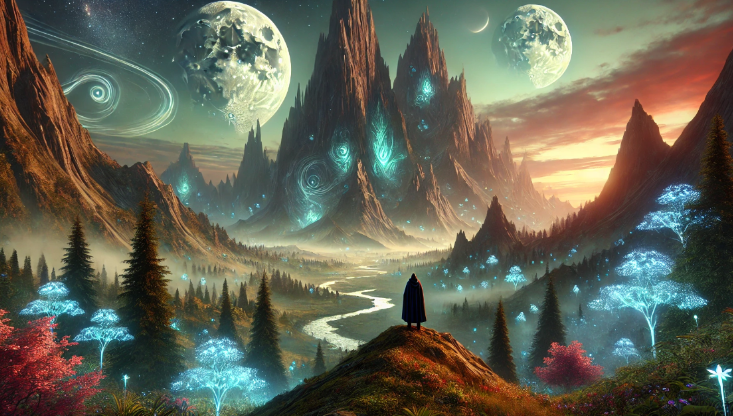
Fantasy writing is like a magic trick—it’s all about making the impossible seem real. But while we tend to focus on dragons, wizards, and epic quests, there’s another key ingredient that often goes unnoticed in a fantasy book: the setting. Picture your favorite fantasy story. Now, imagine it without the enchanted forests, towering castles, or mystical landscapes. It’s a bit like trying to bake a cake without flour—sure, you’ve got the eggs and sugar, but it’s not going to rise to the occasion.
A well-built fantasy setting doesn’t just give your characters a place to hang out; it’s the foundation on which your entire story rests. Think of Middle Earth or Hogwarts—without these worlds, the stories wouldn’t have the same charm. In this article, we’re going to explore how you, too, can create an immersive fantasy setting that transports your readers to a place where the rules of reality are more like guidelines and where anything is possible (even flying brooms and talking swords). Ready to cast the world-building spell? Let’s begin.
What Is Setting in Fantasy?
Fantasy settings are more than just mere backdrops for your story. In fantasy writing, the setting is often as crucial as the plot or characters—it’s the very world your readers will be living in. While a contemporary novel might be set in a recognizable version of our world, a fantasy setting can be a medieval kingdom, a futuristic dystopia, or even a combination of both (think Star Wars, which blends sci-fi and fantasy elements).
The setting in fantasy encompasses everything from the landscape to the culture, politics, magic systems, and even the time period, making it a cornerstone of the fantasy genre. It’s where your world takes shape and provides a dynamic playground for your characters to develop. In short, it’s the scaffolding for everything that happens in your story, and when done right, it can draw readers so deep into your world that they forget they’re not actually there.
Fantasy Worldbuilding: Laying the Foundation
Worldbuilding is the cornerstone of any fantasy setting. It’s where writers get to play god (without the paperwork), creating everything from the ground up. You’re not just building a world; you’re establishing its rules, history, and internal logic. For example, in a high fantasy world like Middle Earth, Tolkien didn’t just stop at describing geography—he invented languages, cultures, and a rich history that spanned thousands of years.
Your Publishing Journey Awaits – Start NowA good fantasy novel needs structure, even if that structure involves dragons flying around eating people. Whether it’s a detailed magic system with clear rules or a fantastical kingdom with its own laws and governance, your readers need to feel that this world makes sense. They don’t have to know every detail, but they need enough breadcrumbs to believe that the world is real within its own framework. And if you’re planning on having talking trees or magical artifacts, they need to fit seamlessly into that framework.
Magic Systems and Fantastical Elements: Adding Depth to Your World
Let’s face it—fantasy novels wouldn’t be fantasy without a little magic. Whether it’s casting spells, wielding enchanted weapons, or telepathically communicating with mythical creatures, a well-developed magic system adds richness and depth to your setting. But here’s the thing: magic in your fantasy world needs rules. If your protagonist can just wave a wand and solve every problem, your plot will deflate faster than a punctured balloon.
Take J.K. Rowling’s Harry Potter series, for example. The magic system is detailed with clear limitations—certain spells require practice, some are illegal, and not everyone can do them. This creates conflict and gives your characters room to grow. When building your own magic system, think about how it influences your world and characters. Does magic drain the user’s energy? Is it a secret art, or does everyone have access to it? Establish these rules early on, and your readers will follow the magic wherever it leads.
History and Lore: Weaving the Past into Your World
History and lore are the bedrock of any compelling fantasy world. They provide a rich tapestry that shapes the present and foreshadows the future. Imagine a fantasy setting without the echoes of ancient wars, legendary heroes, or forgotten civilizations—it would be like a painting without depth. To create a world that feels lived-in and real, you need to weave a past that resonates through every corner of your story.
Consider the major events that have shaped your world. Was there a cataclysmic war that left scars on the land and its people? Perhaps a natural disaster changed the course of history. These events can provide a backdrop for your characters’ struggles and triumphs. Think of significant figures who have left their mark—legendary heroes whose deeds are sung in ballads, powerful rulers whose decisions still influence the present, or influential thinkers whose ideas have shaped society.
Cultural traditions are another vital element. What customs, rituals, and practices are unique to the different cultures within your fantasy world? These details add layers of authenticity and make your world feel diverse and vibrant. Drawing inspiration from real-world history and mythology can help you create a rich and believable lore. Tolkien’s Middle Earth, for example, is steeped in Norse and Anglo-Saxon mythology, giving it a timeless quality.
To keep track of your world’s history, create a timeline outlining major events and milestones. Develop a mythology that explains the origins of your world, its inhabitants, and the forces that shape it. Incorporate historical artifacts—ancient texts, ruins, or relics—that provide clues to the past and influence the present. By weaving the past into your world, you create a setting that draws readers in and refuses to let them go.
Creating Realistic Cultures and Societies in Fantasy Settings
One of the best ways to make your fantasy world feel real is to populate it with diverse cultures and societies, which is a hallmark of the best fantasy settings. Think beyond the typical ‘monarchy-in-a-castle’ trope. Imagine a desert kingdom ruled by a council of elders, or a city built on floating islands where trade is governed by magical winds. The key to creating realistic societies is in the details—what do they value? How do they govern themselves? What are their customs, laws, and taboos?
Don’t be afraid to pull from real-life history and cultures. Many fantasy authors do this—Tolkien’s Middle Earth has echoes of Norse and Anglo-Saxon mythology, while George R.R. Martin’s Seven Kingdoms in Game of Thrones was inspired by medieval Europe. Just make sure to blend real-world influences with enough fantasy to make it fresh and original.
Exploring Different Environments: From Space Stations to Medieval Kingdoms
Fantasy books can be as varied as the human imagination allows. While many classic fantasy stories take place in medieval-style kingdoms (think knights, castles, and trebuchets), no rule says your setting has to stick to this formula. Sci-fi and fantasy often overlap, giving you the freedom to set your story in a space station, an underwater city, or even an entirely different planet.
Think about how the environment affects your characters. A desert world will create challenges different from those of a frozen wasteland. Will your characters need to adapt to gravity that’s lighter or heavier than Earth’s? What kinds of creatures or plants might exist in these environments? By carefully crafting the environment, you can add layers to your story and give your characters something to struggle against, which is always more fun for the reader.
Types of Fantasy Worlds: Exploring Diverse Realms
Fantasy worlds are as diverse as the imaginations that create them. From high fantasy realms filled with knights and dragons to urban fantasy landscapes where magic lurks in the shadows of modern cities, the possibilities are endless. Let’s explore some common types of fantasy worlds and how you can make them your own.
High fantasy worlds are often set in medieval-inspired kingdoms, complete with magical creatures, mythical beasts, and legendary heroes. Think of Tolkien’s Middle Earth or the sprawling realms of The Wheel of Time. These settings are perfect for epic quests and grand battles.
Urban fantasy worlds, on the other hand, bring magic into the modern day. Picture a bustling city where supernatural beings live alongside humans, hidden in plain sight. The Harry Potter series and The Dresden Files are excellent examples of this genre, blending the mundane with the magical.
Historical fantasy worlds weave magical elements into real historical periods. Imagine the Roman Empire with sorcerers in the Senate or Victorian London plagued by supernatural mysteries. This genre allows you to reimagine history with a fantastical twist, as seen in Jonathan Strange & Mr Norrell.
Your Publishing Journey Awaits – Start NowEpic fantasy worlds are vast and intricate, with complex histories, cultures, and mythologies. These settings often span multiple books, allowing for a deep exploration of the world and its inhabitants. George R.R. Martin’s A Song of Ice and Fire series is a prime example, with its richly detailed Seven Kingdoms.
When creating your own fantasy world, draw inspiration from real-world cultures and histories. Blend elements from different time periods and regions to create a unique and diverse setting. Develop a magic system that is consistent and logical within your world, and create a rich geography with diverse landscapes, climates, and ecosystems. By exploring different types of fantasy worlds, you can craft a setting that captivates readers and leaves them eager for more.
Maintaining Internal Consistency in Your Fantasy Setting
One of the most common pitfalls in fantasy writing is inconsistency. If your world operates by its own rules (and it should), then those rules need to stay consistent throughout your story. If magic can suddenly do things it couldn’t do before, or if your characters start violating the laws of your world without consequence, your readers are going to feel like they’re on a rollercoaster with no safety bar.
Think of your fantasy setting as a house of cards. Every new element—whether it’s a new species, a magical artifact, or a fantastical geography—needs to fit within the framework of the world you’ve built. If you start pulling out the wrong cards, the whole thing could come crashing down. Maintaining internal consistency doesn’t mean your world has to be boring or predictable, but it does mean the rules you establish early on should have a clear purpose and remain intact.
The Role of Setting in Character Development and Plot Progression
Fantasy writers know that setting doesn’t just provide a backdrop for your story—it can actively influence character development and plot. Think of the icy north in Game of Thrones, where the harsh climate shapes not only the characters’ survival but also their relationships and decisions. A well-crafted setting should interact with your characters, pushing them to adapt, grow, and evolve.
For instance, a character raised in a wealthy city might struggle to survive in a desolate wilderness, and their journey through that wilderness could become a central part of their character arc. Similarly, the setting can drive the plot forward—whether it’s through the discovery of ancient ruins, navigating treacherous landscapes, or surviving a supernatural storm. In fantasy writing, setting and story are deeply intertwined.
Writing Tips for Fantasy Settings: Enhancing Your Craft
Creating a fantasy setting that captivates readers requires more than just imagination—it demands careful crafting and attention to detail. Here are some tips to enhance your fantasy writing and bring your world to life.
First and foremost, cultivate a sense of wonder. Fantasy settings should evoke awe and curiosity, drawing readers into a world where anything is possible. Incorporate magical creatures, mythical beasts, and legendary heroes to spark the imagination. Think of the awe-inspiring landscapes in The Lord of the Rings or the magical creatures in Fantastic Beasts and Where to Find Them.
Developing a unique magic system is crucial. Your magic should have rules and limitations, making it consistent and believable. Consider how magic works in your world—does it drain the user’s energy? Is it accessible to everyone or only a select few? A carefully curated magic system adds depth and intrigue to your story.
Incorporate sensory details to make your world feel real. Describe the sights, sounds, and smells of your setting to immerse readers fully. The rustling leaves in an enchanted forest, the clinking of armor in a bustling marketplace, or the scent of ancient tomes in a wizard’s library can transport readers into your world.
A rich history is another essential element. Develop a backstory for your world, including major events, significant figures, and cultural traditions. This history should influence the present and shape your characters’ lives. Think of the ancient prophecies in The Wheel of Time or the historical conflicts in A Song of Ice and Fire.
By following these tips, you can create a fantasy setting that is immersive, engaging, and unforgettable. Your readers will be eager to explore every corner of your world and discover the magic within.
Common Mistakes to Avoid in Fantasy Worldbuilding
Building a fantasy world is a complex task, and it’s easy to fall into common pitfalls. Here are some mistakes to avoid to ensure your world is immersive, engaging, and believable.
One common mistake is overly complex worldbuilding. While it’s essential to create a detailed and immersive world, too much complexity can overwhelm readers. Focus on the key elements that drive your story and provide enough detail to make your world feel real without bogging down the narrative.
Your Publishing Journey Awaits – Start NowInconsistent magic systems are another pitfall. A consistent magic system is crucial for creating a believable world. Avoid introducing magical elements that contradict each other or don’t make sense within the context of your world. Establish clear rules and limitations for your magic, and stick to them.
A lack of diversity can make your world feel flat and unrealistic. Fantasy worlds should reflect the complexity and richness of the real world, with diverse cultures, races, and perspectives. Avoid creating homogeneous worlds and strive for inclusivity in your characters and settings.
Overreliance on clichés is another common mistake. While tropes like the “chosen one” or the “evil overlord” can be effective, relying too heavily on them can make your story predictable. Instead, create unique and complex characters that add depth and richness to your world. Subvert traditional tropes to keep readers engaged and surprised.
By avoiding these common mistakes, you can create a fantasy world that is immersive, engaging, and unforgettable. Your readers will be eager to explore every facet of your world and discover the stories within.
Iconic Fantasy Settings: Learning from the Best
Sometimes, the best way to improve your own fantasy writing is to study the master. Iconic settings like Middle Earth, Hogwarts, or the Seven Kingdoms didn’t just happen by accident. These worlds were meticulously crafted, with every detail enhancing the story.
What makes these settings work is their balance of originality and familiarity. Tolkien’s Middle Earth feels like an ancient, forgotten realm, but it’s also rooted in familiar mythologies. J.K. Rowling’s Hogwarts feels like a typical British boarding school—except for the fact that the students are learning spells and potions. By blending the familiar with the fantastical, these authors create worlds that are both immersive and accessible. This distinguishes them from science fiction settings which often occur in vast space environments or on alien planets. Study these settings and see how they might inspire your own world-building efforts.
Conclusion: Building Worlds that Live Beyond the Page
Creating a fantasy setting is like building a sandbox for your readers to play in—one that’s filled with magic, mystery, and adventure. But while it’s tempting to focus on dragons and dark lords, remember that the true power of your fantasy world lies in the details. It’s the bustling markets, the forgotten temples, and the way your characters interact with their environment that makes your world feel alive. And when your readers feel immersed in that world, you know you’ve succeeded.
So, whether you’re writing epic high fantasy or a short speculative fiction tale, don’t skimp on the setting. Build it, explore it, and most importantly, invite your readers to come along for the ride. After all, in a good fantasy story, the setting is as much a character as the protagonist—and if you do it right, it’ll leave an impression long after the final page is turned. Now, go forth and create a world worth getting lost in—just make sure to pack a map.
Ready to bring your fantasy world to life? Spines, makes the publishing process simple and fast, so your story can reach readers in no time. Upload your manuscript and get a free, instant review today—let’s turn your dream into a reality!
Your Publishing Journey Awaits – Start Now





